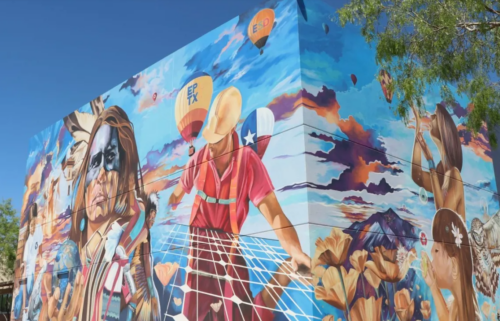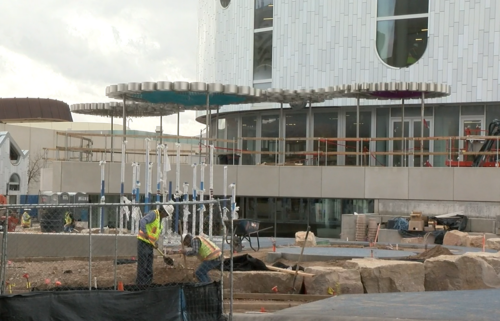Why are there so few women in aviation?

When Southwest Captain Tammie Jo Shults landed a crippled 737 last year after an engine blew apart mid-air, many people were surprised to find out that there was a woman at the helm.
Today, a critical pilot shortage across the world has given women and people of color unprecedented opportunity.
It has turned airline recruiting on its head and, simply owing to supply and demanding, globally salaries are rising dramatically for pilots and aviation maintenance technicians (AMTs).
Today there are more opportunities in the aviation field than at any time in history, including commercial space flight and unmanned systems.
Flight schools report an uptick in female students, according to Flight Schools Association of North America President Bob Rockmaker, whose experience echoed that of aviation universities who report a 10% to 15% increase in women pilots.
Much of this progress is thanks to efforts designed to change the industry’s makeup, which has stubbornly resisted change since the first black man and first white woman were hired by airlines in the 1960s and 1970s. Women pilots have slowly risen from 5% to nearly 7% of airline pilots, but they’ve achieved barely a quiver in the needle over the past decade.
The current state of women in aviation
“Women are underrepresented in many areas of aviation, with the largest gaps in technical operations and leadership positions,” Dr. Rebecca Lutte, University of Nebraska at Omaha Aviation Institute, reported in her study for the nonprofit group Women in Aviation International.
Women in Aviation: A Workforce Report shows women make up less than 10% of pilots, maintenance technicians and airline executives.
“More emphasis is needed to build upon the 3% of women airline executives and 1% of women captains,” Lutte wrote, adding numbers in aerospace engineering, dispatch, cybersecurity, airports and air traffic control need to be tracked. “It is equally important to increase the number of women on the flight deck and the number of board seats.”
Inequality in the air
Women pilots say that part of the problem is work rules which haven’t changed in 50 years.
Indeed, a recent University of Wisconsin study showed women leave within five years because of lack of advancement or desire to achieve work-life balance, indicating this is a problem not just for the flight deck but for the entire aviation and aerospace industries.
While other industries have adapted work rules to accommodate the modern family, aviation and aerospace remain stubbornly unchanged. In fact, according to the study, women who leave aviation usually continue to work outside the home, indicating a lot can be done to retain women in aviation careers.
One possible reason for the gender inequality in aviation is money, as training costs can be as much as $150,000 in the US. But there may be other reasons — and Shannon Morrison, Ohio State University’s Center for Aviation Studies curriculum and assessment manager and diversity and inclusion coordinator, wants to find out what they are.
Morrison is studying the experiences of women of color and the challenges they face which may end their careers before they start. She is trying to discover why the numbers of women, and in particular black women, remain low, despite the efforts around diversity and inclusion in the industry. Having interviewed several black women in a variety of roles (pilots, human resources, and VP’s) Morrison has discovered a disconnect between the experiences of her interviewees and the inclusion practices of the industry.
“Celebrating Black History Month with an all-black flight crew is not the same as creating a corporate culture that supports diverse talent,” she tells CNN Travel. “If the aviation industry is concerned with a talent shortage, then it should also be concerned with attracting diverse talent; by creating a corporate culture that sustains all the individuals who work within it.”
Getting in the front (airport) door
Stories of mothers and sons and fathers and daughters flying together may look like progress, but actually highlight one of the problems. They belie the fact those who aren’t exposed to the aviation industry at a young age don’t even think of aviation careers.
Alaska Airlines Captain Kimberly Ford, who followed in the footsteps of her father, a military pilot, and grandfather, a Tuskegee Airman, cited preparation as a barrier to women and minorities who are not exposed early to aviation careers.
“They may not see people who look like them so they may not think of aviation as a career,” Ford, a graduate of the Air Force Academy and one of three African-American pilots at Alaska, tells CNN Travel.
“They may have never flown. So, when they make the jump into aviation they are knocked out because they don’t have the background. It can be daunting when you walk into a room and all you see is white males. You feel isolated. But I had mentors who followed me all the way through who gave me great feedback to keep me going.”
The importance of mentors was cited by Republic Airways First Officer Shanita Polk.
“I trained in a university flight school that was mostly men,” she tells CNN Travel. “The few minorities I had in my class eventually dropped out. I was the only one to finish. And I initially struggled with the private pilots course, which took me six semesters [instead of] the normal two. I had instructors tell me to give up! Only myself and my mother kept me motivated. I enjoyed becoming a flight instructor because I wanted to motivate and encourage the underdogs.”
But the environment has changed dramatically since Polk was in school.
Dozens of groups such as the Organization of Black Aerospace Professionals (OBAP) and the Latino Pilots Association recruit students to build out the paltry ranks of people of color and provide the mentorship they need not only to start but to succeed. All professional organizations and airlines offer millions of dollars in scholarships and mentor programs.
Industry outreach also includes programming from kindergarten through high school, aviation curriculum development as part of STEM education, the creation of aviation high schools that are busing inner-city kids to campus and Women in Aviation International’s annual Girls in Aviation Day designed to introduce girls to aviation careers in cities around the world.
Without them, there will be no airline expansion or anyone to fly the thousands of aircraft on order. In fact, the US aviation maintenance industry experiences $1.4 billion a year in lost economic activity, according to an Aeronautical Repair Station Association survey, for lack of high-tech, high-paid AMTs.
Moving up to 30,000 feet
Women are also making their way into management roles, a key barrier reported by women pilots.
Republic Airways’ chief pilot is a woman, as is the head of its new Lift pilot academy. United, whose system chief pilot is a woman, reports women constitute about 7% of pilots and Delta reported 7.4% of new hire pilots in the past four years have been women.
Airlines have all pledged to redress the diversity imbalance as well as the unconscious and conscious bias in all areas from management to maintenance bay. Both JetBlue and American have created cadet academies to train people with no aviation experience, providing scholarships and financing.
Passenger and cargo airlines have career pathway programs shepherding students through flight school or aviation universities to their regional airline partners and ultimately to the mainline airline.
First in flight, first in class
While providing programs to attract and retain employees is important, according to Aerospace Industries Association CEO Eric Fanning, the key is attracting students as early as kindergarten and then keeping them in STEM studies throughout their education.
Fanning cites an industry study showing students who are initially excited about STEM begin to turn away as they reach third or fourth grade and then again as they transition from grade to high school.
Airlines and aircraft manufacturers are rapidly catching on to their gender and race challenges and creating programs such as Boeing’s “Return to Flight” program to recruit former employees who left to raise children. Others are launching re-skilling programs to accommodate growing automation.
Boeing’s forecast requires 804,000 civil aviation pilots and 769,000 AMTs by 2036. It’s likely that many more of those faces will be female.



